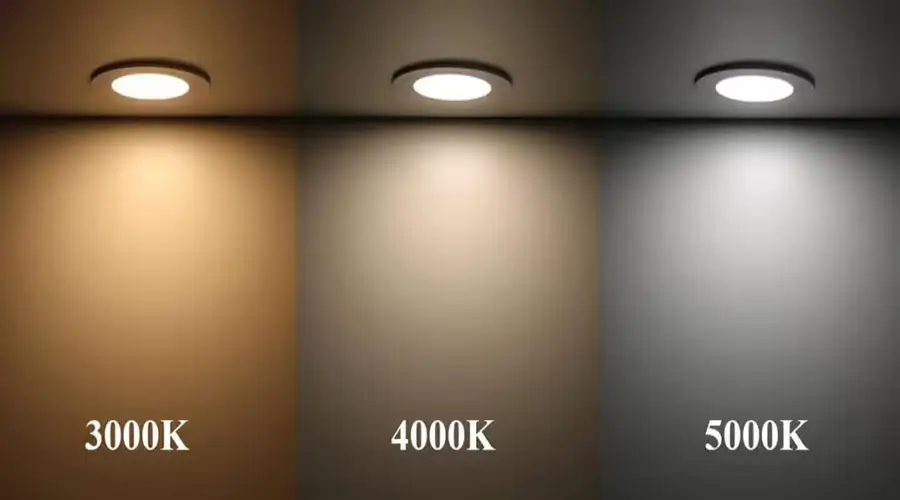
With the development of LED lights, more and more people are paying attention to the impact of artificial lighting on eye health. Most people focus on 3000K vs. 4000K, and 4000K vs. 5000K light attracts everyone’s attention. Among various color temperatures, there are concerns about the potential impact of 4000K on eye health.
In this article, let’s discuss the characteristics and applications of 4000K light, and analyze common questions about whether 4000K affects eye health.
What is 4000K Light?
4000K refers to the color temperature of light, measured in Kelvin (K). The light it emits is neither too cold nor too warm, falling into the neutral white light range.
4000K is a popular color temperature because it provides a balance between warm and cool tones. At 4000K lighting appears natural and daylight-like, suitable for a variety of indoor and outdoor environments.
Where is 4000K Mainly Used?
4000K light is widely used in residential, commercial and architectural lighting. Most people will choose 4000K to balance indoor and outdoor lighting.
- Dining room, kitchen, bathroom.
- Offices, schools, retail stores and healthcare.
- Street lighting, parking and security lighting.

Is 4000K Light Harmful to Eyes?
4000K light itself is not harmful to the eyes if installed and used correctly. Because 4000K lighting can provide comfortable lighting, it is neither too bright nor too dark. So it won’t cause eye fatigue or discomfort.
However, prolonged or overexposure to any bright light source (such as 4000K lighting) may cause temporary discomfort or fatigue. It is important to ensure adequate lighting levels and take regular breaks to rest your eyes.
Is 4000K Suitable for Reading?
Yes, 4000K light is great for task lighting. It’s suitable for reading and other visually demanding tasks. 4000K can provide good color rendering and contrast, making text and images appear clear and easy to read.
Many people find 4000K lighting beneficial for reading, studying, and performing tasks that require visual precision. Because the light it produces is not too bright or too dark, it is very friendly to the eyes.

Which Color Temperature is Better for Eyes?
The optimal color temperature for eye comfort may vary based on personal preference and perception. And there is also the time of exposure to light to compare.
Some people may prefer warm colors to create a cozy atmosphere, and it feels very comfortable. But others may prefer cooler colors for tasks that require concentration, which they may find more practical. Ultimately, choosing lighting that suits individual needs and promotes visual comfort is crucial. Also, remember not to be exposed to any light for long periods of time.
Summarize
4000K light is a versatile and versatile lighting color temperature. It provides balanced lighting suitable for a variety of applications. Although there are concerns about its impact on eye health. But if installed and used properly, 4000K lighting can provide comfortable, efficient lighting without adversely affecting the eyes. Choose the right one, considering factors such as brightness, glare and task requirements, to ensure optimal visual comfort and well-being.
FAQs
4000K light is considered good for the eyes if installed and used correctly. Because it provides balanced, neutral white lighting that is neither too warm nor too cold. It provides enough brightness without causing eye fatigue or discomfort.
4000K is about versatility and balancing the color temperature of various lights, it has many advantages. At the same time, it can provide accurate color rendering and improve production and work efficiency. Create an environment conducive to working and learning.
Both 4000K and 6000K lighting are good for the eyes, depending on the specific application and personal preference. The 4000K light provides balanced lighting suitable for a variety of tasks and environments, while the 6000K lighting provides cooler, daylight-like brightness. However, they cannot be exposed to artificial lighting for a long time to ensure eye comfort.
Yes, 4000K light is good for reading. Because it offers a neutral white color temperature, it improves text clarity and reduces eye fatigue. The balanced lighting of 4000K light provides enough brightness without causing eye discomfort during long reading sessions.
Generally, people will prefer to install 2700K and 3000K in the living room. Whether 4000K lighting is too bright for a living room depends on personal preference and desired ambience. While 4000K lights can provide plenty of brightness for tasks and activities, most people prefer a warmer color temperature to create a more comfortable, relaxing atmosphere in their living room.
